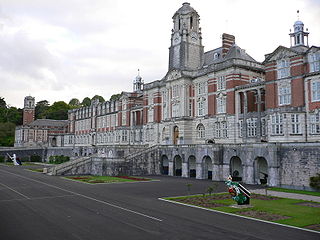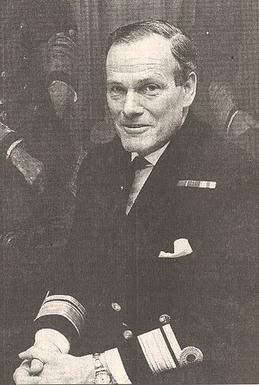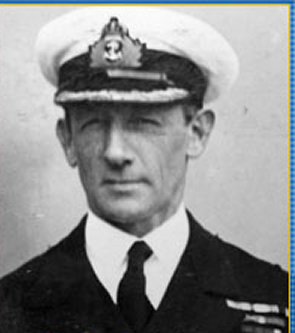
The Second Sea Lord and Deputy Chief of Naval Staff is deputy to the First Sea Lord and the second highest-ranking officer to currently serve in the Royal Navy and is responsible for personnel and naval shore establishments. Originally titled Second Naval Lord in 1830, the post was restyled Second Sea Lord in 1904. They are based at Navy Command, Headquarters.

Britannia Royal Naval College (BRNC), commonly known as Dartmouth, is the naval academy of the United Kingdom and the initial officer training establishment of the Royal Navy. It is located on a hill overlooking the port of Dartmouth, Devon, England. Royal Naval officer training has taken place in Dartmouth since 1863. The buildings of the current campus were completed in 1905. Earlier students lived in two wooden hulks moored in the River Dart. Since 1998, BRNC has been the sole centre for Royal Naval officer training.
Admiral of the Fleet Sir David Benjamin Bathurst, is a former Royal Navy officer. He is the only living person, apart from King Charles III, holding the rank of Admiral of the Fleet in the Royal Navy since the death of Lord Boyce. After training as a pilot and qualifying as a helicopter instructor, Bathurst commanded a Naval Air Squadron and then two frigates before achieving higher command in the navy. He served as First Sea Lord and Chief of the Naval Staff from 1993 to 1995: in that capacity he advised the British Government on the deployment of Naval Support including Sea Harriers during the Bosnian War.

Admiral Sir John Cunningham Kirkwood Slater,, known as Jock Slater, is a retired Royal Navy officer. He commanded a minesweeper, a frigate and then a destroyer before taking over the aircraft carrier HMS Illustrious and then achieving higher command in the Navy. He served as First Sea Lord and Chief of the Naval Staff from 1995 to 1998: in that capacity he played a key role in the 1998 Strategic Defence Review carried out by the Labour Government that had come to power a year earlier.
Admiral Sir David John Hallifax, was a senior Royal Navy officer who served as Constable and Governor of Windsor Castle from 1988 until 1992.

Admiral of the Fleet Sir John Julian Robertson Oswald was a senior Royal Navy officer. After training as a gunnery specialist, Oswald commanded a frigate and then a destroyer before achieving higher command in the navy. He served as First Sea Lord and Chief of Naval Staff in the early 1990s. In that capacity he advised the British Government on the reduction in the size of the fleet under the Options for Change restructuring programme and on the deployment of Naval Support for the Gulf War in 1991: he also made the decision that members of the Women's Royal Naval Service should be allowed to serve in Royal Navy ships.
Captain Sir Nicholas Peter Wright, KCVO was Private Secretary to The Princess Royal from 2002 to 2019. On his retirement from the post he was appointed an Extra Equerry to Her Royal Highness from 1 February 2019.

Admiral of the Fleet Sir William Doveton Minet Staveley was a Royal Navy officer. Staveley saw service as a minesweeper commander on coastal patrol during the Indonesia–Malaysia confrontation before commanding a frigate and then an aircraft carrier and ultimately achieving higher command in the Navy. He served as First Sea Lord and Chief of Naval Staff in the late 1980s. In that role he fought hard for a fleet large enough to meet NATO commitments.

Admiral Sir Gerald Louis Charles Dickens was a senior Royal Navy officer and the grandson of Victorian novelist Charles Dickens.
Admiral Sir Michael Henry Gordon Layard, is a retired senior Royal Navy officer who served as Second Sea Lord from 1992 to 1995.

Admiral Sir Brian Thomas Brown, was a senior Royal Navy officer who served as Second Sea Lord and Chief of Naval Personnel from 1988 to 1991.

Admiral Sir Michael Maynard Denny was a Royal Navy officer who went on to be Third Sea Lord.
Vice Admiral Malcolm Graham Rutherford was a Royal Navy officer who became Deputy Chief of the Defence Staff.

The Flag Officer Scotland and Northern Ireland (FOSNI) was a senior post in the Royal Navy of the United Kingdom. It was based at HM Naval Base Clyde, and the holder of the post was the Royal Navy’s senior officer in Scotland. The post of FOSNI, dating from 1946, was re-scoped and re-named in 1994 to Flag Officer Scotland, Northern England & Northern Ireland (FOSNNI), then named back in 2015, before being dis-established in 2020.

Vice-Admiral Arthur Edward Frederick Bedford, CB, CSI was a Royal Navy officer. He served in HMS Kent at the Battle of the Falkland Islands of 1914 and rose to command the Royal Indian Navy from 1934 to 1937, when he retired. A year later he rejoined the colours and served until the end of the Second World War.

Admiral Sir Philip Andrew Jones, is a retired senior Royal Navy officer. After service in the South Atlantic in 1982 during the Falklands War, he commanded the frigates HMS Beaver and HMS Coventry. He went on to be Flag Officer, Scotland, Northern England and Northern Ireland, Commander United Kingdom Maritime Forces and Assistant Chief of the Naval Staff before being appointed Fleet Commander and Deputy Chief of the Naval Staff. Jones served as First Sea Lord from April 2016 to June 2019.

Rear Admiral Simon Paul Williams, is a retired senior Royal Navy officer who served as Naval Secretary, Assistant Chief of Naval Staff (Personnel) and Flag Officer from March 2015 to June 2018.
Rear Admiral Christopher Allen Snow CBE, DL is a former Royal Navy officer who served as Flag Officer Sea Training.

Admiral Sir Benjamin John Key, is a senior Royal Navy officer. He has served as First Sea Lord since November 2021. He has commanded HM Ships Sandown, Iron Duke and Lancaster, and deployed on operations to Kosovo and Iraq. He was appointed Fleet Commander in 2016, and the Chief of Joint Operations in 2019.
In 1989 the Royal Navy was under the direction of the Navy Department in the UK Ministry of Defence. It had two main commands, CINCFLEET and Naval Home Command.












